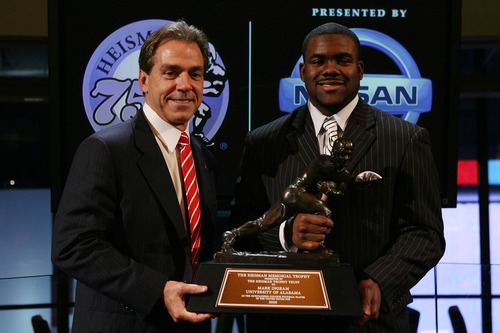In the world of college football, few names resonate as profoundly with the University of Alabama as Mark Ingram II. The first Crimson Tide player ever to win the prestigious Heisman Trophy, Ingram’s journey from standout running back to NFL veteran and now, to coach at his alma mater, marks a significant moment not only for him but for Alabama football as a whole. His official return to Tuscaloosa as a member of the Alabama coaching staff is an inspiring full-circle story that highlights the lasting impact of a player who was instrumental in building Alabama’s early dynasty under legendary head coach Nick Saban.
Mark Ingram II’s career has been one defined by excellence, perseverance, and loyalty. When he burst onto the college football scene in 2008, few could have predicted the enduring legacy he would leave at Alabama. As a freshman, Ingram’s electrifying runs and relentless work ethic helped the Crimson Tide capture the BCS National Championship in 2009, setting the stage for what would become one of the most dominant programs in college football history. That season, Ingram’s prowess was impossible to ignore, as he earned the Heisman Trophy, becoming the first Alabama player to do so since the award’s inception in 1935. His triumph was more than just an individual accolade; it was a signal that Alabama had returned to the pinnacle of college football and that a new era was dawning under Saban’s leadership.
Over the next several years, Ingram continued to be a cornerstone of the Crimson Tide offense. His blend of speed, power, and vision allowed him to rack up impressive numbers, consistently providing the team with the kind of ground game that kept defenses honest. His leadership on and off the field embodied the culture Nick Saban had been meticulously building—a culture centered on discipline, toughness, and an unyielding desire to win. As Alabama amassed national titles and became a breeding ground for NFL talent, Ingram’s name was forever etched in the program’s storied history.
After his collegiate career, Ingram took his talents to the NFL, where he enjoyed a successful professional career spanning over a decade. Playing for teams like the New Orleans Saints, Baltimore Ravens, and Houston Texans, he was known for his reliability, versatility, and professionalism. But throughout his time in the NFL, the bond with his alma mater remained strong. Ingram frequently spoke about how Alabama shaped him not only as a player but as a person, instilling values that transcended football.
His return to Tuscaloosa in a coaching capacity is more than just a nostalgic reunion—it is a strategic move that could have a profound impact on the Crimson Tide’s program moving forward. Alabama’s recent seasons have demonstrated the challenge of sustaining dominance amid evolving college football landscapes, including the transfer portal, NIL deals, and heightened competition across the SEC and beyond. Bringing in a former Heisman winner who truly understands the nuances of Alabama football culture and the demands of elite competition is a masterstroke by the coaching staff.
Ingram’s unique blend of firsthand experience as a player who reached the highest heights and a veteran of the professional ranks equips him with invaluable insights for today’s young athletes. He can serve as both a mentor and a motivator, guiding running backs not only through the technical aspects of the game but also through the mental and emotional challenges they face. His story—from a high school prospect in Alabama to a college legend to an NFL pro—serves as a beacon of what is possible with dedication and perseverance.
Moreover, Ingram’s presence on the coaching staff sends a clear message to recruits and fans alike. It signals that Alabama is committed to fostering a culture that respects its history while constantly innovating and evolving. Players will see that there is a direct line from playing for Alabama to building a professional career and, now, to giving back and shaping future generations. This continuity is vital in maintaining Alabama’s status as a top destination for elite football talent.
Ingram’s return also coincides with a critical phase in Nick Saban’s tenure. While Saban remains the undisputed leader of the program, the integration of former players into the coaching ranks can inject fresh energy and perspective. Former players like Ingram understand the contemporary challenges student-athletes face, from balancing academics and athletics to navigating NIL opportunities and social pressures. They bring relatability that complements Saban’s proven leadership.
Ingram’s role on the coaching staff will likely involve working closely with the running backs, the position where he excelled and made his name. Alabama has a tradition of producing elite running backs who succeed at the college level and transition smoothly to the NFL. Names like Derrick Henry, Najee Harris, and more recently, Jahmyr Gibbs and Brian Robinson Jr., have followed this lineage. Ingram’s presence can help maintain and elevate this pipeline. His experience in the NFL, including managing the physical toll and mastering game preparation, will be invaluable for guiding young athletes aiming for professional careers.
Beyond X’s and O’s, Ingram’s impact may extend into recruiting and community relations. As a homegrown Alabama hero, he embodies the spirit and identity of the state and the university. His story resonates not just with players but with fans and alumni, who take immense pride in the legacy of their football program. Ingram’s connection to the community and his visibility as a successful former player turned coach can strengthen ties between the program and its supporters.
This move also reflects a broader trend in college football, where programs increasingly tap into their own alumni networks to build coaching staffs. Former players bring credibility, firsthand knowledge of the program’s culture, and an emotional investment that external hires sometimes lack. Alabama’s decision to add Mark Ingram II to their coaching ranks follows similar moves by other top programs that have reintegrated past stars into developmental roles.
Mark Ingram II’s return to Alabama coaching staff comes with expectations but also with tremendous opportunity. Fans will look to see how his leadership shapes the development of Alabama’s running backs and how his presence influences the locker room culture. Coaches and players alike will benefit from his experience navigating the rigors of collegiate and professional football, as well as his understanding of the unique pressures that come with wearing the Alabama jersey.
For Ingram personally, this chapter is undoubtedly a dream realized. Coaching at your alma mater, especially one where you achieved historic success, is an honor few get to experience. It offers him the chance to leave a lasting legacy not only through his own career achievements but through the successes of those he mentors and develops. It’s an opportunity to give back to the program that shaped him and to help ensure that the Crimson Tide’s tradition of excellence continues for generations to come.
In the grand narrative of Alabama football, Mark Ingram II’s story is already legendary. Now, as he steps into the role of coach, that story enters a new phase—one filled with promise, challenges, and the potential to influence the future of one of college football’s greatest dynasties. Tuscaloosa welcomes home one of its most celebrated sons, ready to watch him build the next chapter in Alabama football history.



